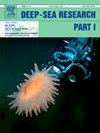南海北部内孤立波到达时间的变化
IF 2.1
3区 地球科学
Q2 OCEANOGRAPHY
Deep-Sea Research Part I-Oceanographic Research Papers
Pub Date : 2025-04-18
DOI:10.1016/j.dsr.2025.104505
引用次数: 0
摘要
2019年和2020年在南海北部一个监测站进行的系泊观测显示,春潮期间每天有两个内孤立波(ISWs)包,这一发现与之前的报告一致。根据到达时间,南海北部的isw通常分为两种类型:每隔24小时出现一次的a型波和每隔25小时出现一次的b型波。然而,在本研究中观察到的两个每日ISW包在到达时间间隔上没有显着差异。相反,它们的到达时间相互转换;即,在两个连续的小潮周期中交换的两个ISW包的到达时间,表明ISW到达时间是由潮汐本身调制的,而不是由特定频率的潮汐成分调制的。除了过渡现象外,isw到达时间间隔与背景潮峰间隔之间存在逐日偏差。小潮-大潮周期的潮汐不平等调节了日偏差,即较强的潮汐产生较大的isw和较高的相速。由于相位速度的不同,观测站记录到的到达时间间隔也不同。日较差随观测站与ISW产生点距离的增加而增大。这些发现突出了将现场观测到的isw分类为a型或b型的挑战。本文章由计算机程序翻译,如有差异,请以英文原文为准。
Variation in the arrival time of internal solitary waves in the northern South China Sea
Mooring observations conducted at a station in the northern South China Sea (SCS) in 2019 and 2020 revealed two daily packets of internal solitary waves (ISWs) during spring tides, a finding consistent with previous reports. On the basis of arrival time, ISWs in the northern SCS are usually classified into two types: type-a waves that appear at 24-h intervals and type-b waves that appear at approximately 25-h intervals. However, the two daily ISW packets observed in this study exhibited no notable differences in arrival time intervals. Instead, their arrival times mutually transitioned; that is, the arrival time of the two ISW packets interchanged during two consecutive neap-spring cycles, demonstrating that ISW arrival time is modulated by the tide itself rather than by a tidal constituent of specific frequency. In addition to the transition phenomenon, daily deviations were found between the arrival time interval of the ISWs and the background tidal peak intervals. The daily deviations were modulated by the tidal inequality of the neap-spring cycle, whereby stronger tides generate larger ISWs with higher phase speeds. The difference in phase speed resulted in the different arrival time intervals recorded at the observing station. Furthermore, daily deviation magnitudes increased with the distance between the observing station and the ISW generation site. These findings highlight the challenges in classifying field-observed ISWs into type-a or type-b categories.
求助全文
通过发布文献求助,成功后即可免费获取论文全文。
去求助
来源期刊
CiteScore
4.60
自引率
4.20%
发文量
144
审稿时长
18.3 weeks
期刊介绍:
Deep-Sea Research Part I: Oceanographic Research Papers is devoted to the publication of the results of original scientific research, including theoretical work of evident oceanographic applicability; and the solution of instrumental or methodological problems with evidence of successful use. The journal is distinguished by its interdisciplinary nature and its breadth, covering the geological, physical, chemical and biological aspects of the ocean and its boundaries with the sea floor and the atmosphere. In addition to regular "Research Papers" and "Instruments and Methods" papers, briefer communications may be published as "Notes". Supplemental matter, such as extensive data tables or graphs and multimedia content, may be published as electronic appendices.

 求助内容:
求助内容: 应助结果提醒方式:
应助结果提醒方式:


